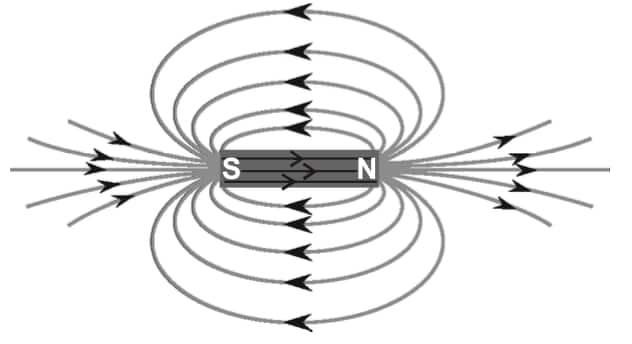Magnetic Field - Definition, Formula, Diagram, Properties, FAQs
Magnetic field is a region around a magnet or a current-carrying conductor where magnetic forces can be detected. The concept of magnetic field was first observed by Hans Christian Orsted in 1820, who noticed that a compass needle is deflected when placed near a current-carrying wire/conductor. A magnetic field is a vector quantity, which means it has both magnitude and direction. It is represented by magnetic field lines which show the direction in which the north pole of a compass would point. Magnetic fields are produced by magnets, electric currents, and changing electric fields. The strength and direction of a magnetic field depend on the source of the field and the distance from it. In this article, you will learn everything about magnetic fields, including direction, formula, properties, applications, and how they are created by.
This Story also Contains
- What is a Magnetic field?
- History of Magnetic Field
- What are Magnetic Field Lines?
- Magnetic Field Intensity
- How is Magnetic Field Created?
- Properties of Magnetic Field Lines
- Uses of Magnetic Field

Also read -
What is a Magnetic field?
Magnetic fields are defined as the area around a magnet where the influence of the magnet can be felt. It has both magnitude and direction, and the magnetic field, as well as its field and direction, are represented by magnetic field lines.
S.I. Unit of Magnetic field is Tesla (T). and it is represented by B.

History of Magnetic Field
- The study of magnetism began thousands of years ago when people discovered naturally magnetized stones called lodestones.
- The ancient Greeks and Chinese noticed that these stones could attract iron and always point in a particular direction when allowed to move freely.
- Around the 11th century, the Chinese used lodestones to make the first magnetic compasses for navigation.
- In the 17th century, William Gilbert, an English scientist, proved that the Earth itself acts like a giant magnet.
- Later, in the 19th century, Hans Christian Ørsted discovered that electric current produces a magnetic field.
- This led to the development of electromagnetism, further explained by James Clerk Maxwell, who united electricity and magnetism into one theory.
What are Magnetic Field Lines?
Magnetic field lines are imaginary lines that encircle a magnet. The density of a field's line indicates its magnitude. The magnetic field is strongest around the Poles of a magnet and weakens as it goes away from the poles.
Experiment to Observe Magnetic Field
A simple experiment can help to clarify the concept of magnetic field lines. Fix a sheet of white paper to a table and centre it with a bar magnet. Iron filings should be sprinkled around the magnet. Tap the table gently. It can be seen that the iron filings align in a certain pattern that represents the magnet's field. When these patterns are well examined, it is possible to see that iron filings collect around the poles, but the concentration is lower in the region away from the poles.
Magnetic Field Intensity
Magnetic field intensity is a measure of the strength of a magnetic field at a given point. It indicates how strongly a magnetic field can magnetise a material placed in it. It is denoted by H and is a vector quantity, having both magnitude and direction. The SI unit of magnetic field intensity is ampere per meter (A/m). Its direction is the same as that of the magnetic field lines. The magnetic flux density $B$ is related to magnetic field intensity $H$ by the formula:
$
B=\mu H
$
where $\mu$ is the magnetic permeability of the material.
How is Magnetic Field Created?
A magnetic field can be produced not just by a magnet, but also by a moving charge or electric current. We are all aware that matter is made up of small bits known as atoms. An atom's nucleus is made up of protons and neutrons, with electrons orbiting around it. The magnetic field is created by the spinning and circling of protons and neutrons or the nucleus of an atom. The magnetic field's direction is determined by the orbit and spin directions.
Properties of Magnetic Field Lines
1. Magnetic field lines never cross each other.
2. It follows the path with the least resistance between the opposing magnetic poles. A bar magnet's magnetic lines of force travel in closed loops from one pole to the other.
3. The density of the field lines decreases as they pass from the higher permeability region to the lower permeability region.
4. Lines travel from the south pole to the north pole within a material magnetic field, while in the air, they flow from the north pole to the south pole.
5. The density of the magnetic field varies with distance from the pole. Their density reduces as one moves away from the pole.
6. Because it has both magnitude and direction, the magnetic field is a vector quantity.
Properties of Earth's Magnetic Field
1. The magnetic field of the Earth is uniform.
2. The magnetic field strength at the earth's surface is about 10-4 Tesla.
3. The earth's magnetic field extends up to a height of 5 times the radius of the earth.
Uses of Magnetic Field
Magnetic fields have numerous applications in everyday life, industry, and technology. Some of the important uses are as follows:
Electromagnets
Magnetic fields are used to produce electromagnets, which can be turned on or off by controlling the electric current. Electromagnets are commonly employed in cranes for lifting heavy iron and steel objects.
Electric Motors and Generators
In electric motors, magnetic fields are used to convert electrical energy into mechanical energy. Conversely, generators utilize magnetic fields to convert mechanical energy into electrical energy through electromagnetic induction.
Transformers
Magnetic fields enable transformers to transfer electrical energy from one circuit to another efficiently, without any direct connection, by means of electromagnetic induction.
Magnetic Storage Devices
Data storage devices such as hard disks, tapes, and credit cards make use of magnetic fields to store information reliably.
Medical Applications
Magnetic fields are employed in medical imaging techniques such as Magnetic Resonance Imaging (MRI), which provides detailed internal images of the human body without using harmful radiation.
|
Related Topics |
Frequently Asked Questions (FAQs)
Yes, space contains magnetic fields. The spiral arms of the Milky Way seem, on the basis of investigations of several pulsars and the polarisation of their radio waves, a very big organised magnetic field. Magnetic fields were observed in interstellar dust clouds. The fields are increased as these clouds collapse.
Factors that affect the strength of an electromagnet's magnetic field: Factors that influence electromagnet strength are the nature of the core material, the current strength of the core, the number of turns on the centre, and the shape and size of the core.
A magnet's form has an impact on its force. If there is a pointing end of a magnet, it is stronger than the remainder of the magnet. It's because the form impacts the magnetic energy distribution in the region it occupies.
Magnetic fields have many applications in daily life and technology. They are used to make electromagnets, operate electric motors and generators, transfer energy in transformers, store data in hard drives and tapes, perform medical imaging with MRI, help in navigation using compasses, control relays and sensors, and accelerate particles in cyclotrons and particle accelerators.
The SI unit of magnetic field is Tesla (T). Another commonly used unit is Gauss (G), where 1 Tesla = 10,000 Gauss.
For the following reasons, magnetic flow lines are important:
1. The magnetic field lines shall be lines in a magnetic field, whose tangent shall give direction at every location of the field, and their density shall give field magnitude.
2. They mark the magnetic field direction.
3. Intensity of the magnetic field varies on the number of lines.
4. The lines at the poles are higher, thus the magnetic field at the poles is more powerful.
5. The force of the magnetic field depends on the number of magnetic field lines in a certain location.
The magnetic field is stronger in the poles because the field lines are most concentrated there. Field lines also demonstrate what happens to the magnetic fields of two magnets when they attract or repel one another.